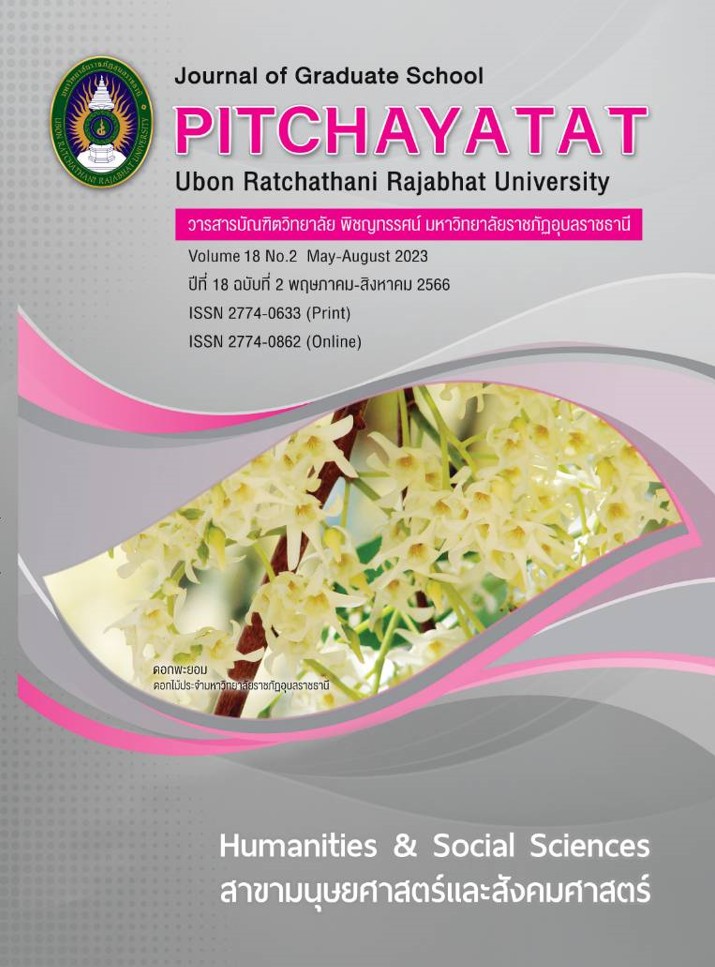การพัฒนาการจัดการเรียนรู้ด้วยเทคนิคการเสริมต่อการเรียนรู้ เพื่อส่งเสริมความคิดสร้างสรรค์ ในรายวิชาการงานอาชีพของนักเรียนชั้นมัธยมศึกษาปีที่ 3 โดยใช้แบบแผนการทดลอง แบบรองรับภายใน
คำสำคัญ:
เทคนิคการเสริมต่อการเรียนรู้, ความคิดสร้างสรรค์, แบบแผนการทดลองแบบรองรับภายในบทคัดย่อ
การวิจัยนี้มีวัตถุประสงค์เพื่อ 1) พัฒนาการจัดการเรียนรู้ด้วยเทคนิคการเสริมต่อการเรียนรู้โดยใช้แบบแผนการทดลองแบบรองรับภายในที่ส่งเสริมความคิดสร้างสรรค์ของนักเรียน 2) เปรียบเทียบความคิดสร้างสรรค์ของนักเรียนที่ได้รับการจัดการเรียนรู้ด้วยเทคนิคการเสริมต่อการเรียนรู้ เมื่อวัดก่อนเรียนและหลังเรียน โดยใช้แบบแผนการทดลองแบบรองรับภายใน ตัวอย่างคือนักเรียนชั้นมัธยมศึกษาปีที่ 3 โรงเรียนป่าแดงหนองฮูหนองตอโนนไทย จำนวน 17 คน ซึ่งได้มาโดยวิธีการสุ่มแบบหลายขั้นตอน เครื่องมือที่ใช้ ได้แก่ 1) แบบสัมภาษณ์ครูผู้สอนวิชา คหกรรม 2) แบบสัมภาษณ์ภูมิปัญญาท้องถิ่น 3) แผนการจัดการเรียนรู้ 4) แบบวัดความคิดสร้างสรรค์ 5) แบบสังเกตพฤติกรรมความคิดสร้างสรรค์ของนักเรียน และ 6) แบบสัมภาษณ์ความคิดสร้างสรรค์ของนักเรียน สถิติที่ใช้ ได้แก่ ค่าเฉลี่ย ค่าส่วนเบี่ยงเบนมาตรฐาน ทดสอบสมมติฐานด้วย การวิเคราะห์ความแปรปรวนพหุคูณแบบทางเดียวโดยมีการวัดซ้ำ (One-way MANOVA; repeated measures) และคำนวณค่า Hotelling’s T2 แบบวัดซ้ำ
ผลการวิจัยพบว่า
- การจัดการเรียนรู้ด้วยเทคนิคการเสริมต่อการเรียนรู้ ที่ตรวจสอบคุณภาพโดยผู้เชี่ยวชาญ มีค่าเฉลี่ยอยู่ระหว่าง 4.53–4.75 ส่วนเบี่ยงเบนมาตรฐานอยู่ระหว่าง 0.36–0.62 โดยรวมอยู่ในระดับมากที่สุด
- ผลการพัฒนาการจัดการเรียนรู้ด้วยเทคนิคการเสริมต่อการเรียนรู้เมื่อนำไปใช้กับตัวอย่าง พบว่า นักเรียนมีคะแนนเฉลี่ยความคิดสร้างสรรค์ในภาพรวมและรายด้าน ด้านความคิดคล่องแคล่ว ด้านความคิดยืดหยุ่น ด้านความคิดริเริ่ม และด้านความคิดละเอียดลออ ระหว่างก่อนเรียนและหลังเรียน แตกต่างกันอย่างมีนัยสำคัญทางสถิติที่ระดับ .05
เอกสารอ้างอิง
เกศแก้ว คงคล้าย. ผลของการเรียนรู้จากตัวแบบร่วมกับกลวิธีการเสริมต่อการเรียนรู้ที่มีต่อความสามารถในการอ่านทำนองเสนาะและเจตคติต่อการอ่านทำนองเสนาะของนักเรียนชั้นมัธยมศึกษาปีที่ 5. วิทยานิพนธ์การศึกษามหาบัณฑิต มหาวิทยาลัยศรีนครินทรวิโรฒ, 2562.
ไกรยศ ภัทราวาท. กสศ. ขอการแก้ความเหลื่อมล้ำการศึกษาด้วย สะพานบุญ-ผีเสื้อ ที่เข้าไปอยู่ในใจคน. (ออนไลน์) 2563 (อ้างเมื่อ 20 ตุลาคม 2563). จาก https://thaipublica.org/2020/10/eef-kraiyos-patrawart/
เขตพื้นที่การศึกษาประถมศึกษาร้อยเอ็ด เขต 1, สำนักงาน. ข้อมูลพื้นฐานทางการศึกษาเอกสารข้อมูลพื้นฐานทางการศึกษาของนักเรียน. ร้อยเอ็ด: สำนักงานเขตพื้นที่การศึกษาประถมศึกษาร้อยเอ็ด เขต 1, 2565.
จินตนา ศุภกรธนสาร. “การพัฒนารูปแบบการจัดกิจกรรมการเรียนรู้การงานอาชีพและเทคโนโลยี เพื่อส่งเสริมความคิดสร้างสรรค์และทักษะงานประดิษฐ์ของนักเรียนประถมศึกษาปีที่ 4,” วารสารวิชาการสถาบันพัฒนาศักยภาพกำลังคน เขตพัฒนาพิเศษภาคตะวันออก. 1, 2 (พฤษภาคม-สิงหาคม 2564): 60.
ชัยวัฒน์ สุทธิรัตน์. 80 นวัตกรรมการจัดการเรียนรู้ที่เน้นผู้เรียนเป็นสำคัญ. พิมพ์ครั้งที่ 6. นนทบุรี: พี บาลานซ์ดีไซด์แอนปริ้นติ้ง, 2558.
นงลักษณ์ เขียวมณี. การศึกษาผลสัมฤทธิ์ทางการเรียน กลุ่มสาระการเรียนรู้การงานอาชีพและเทคโนโลยีและความสามารถในการคิดสร้างสรรค์ ของนักเรียนชั้นมัธยมศึกษาปีที่ 3 โดยวิธีการจัดการเรียนรู้แบบใช้โครงงานเป็นฐาน. วิทยานิพนธ์ครุศาสตรมหาบัณฑิต มหาวิทยาลัยราชภัฏวไลยอลงกรณ์ ในพระบรมราชูปถัมภ์, 2562.
นพมาศ ปลัดกอง. การพัฒนาการเรียนรู้ด้วยการนำตนเองของผู้เรียนในระบบการศึกษาทางไกล โดยใช้รูปแบบการจัดการเรียนรู้ด้วยเทคนิคนั่งร้านเสริมเรียนรู้. วิทยานิพนธ์ปรัชญาดุษฏีบัณฑิต มหาวิทยาลัยศรีนครินทร วิโรฒ, 2562.
พีระพล ชูศรีโฉม. ผลการจัดการเรียนรู้สุขศึกษาโดยใช้การสอนแบบเสริมต่อการเรียนรู้ที่มีผลต่อผลสัมฤทธิ์ทางการเรียนและทักษะการคิดขั้นสูงของนักเรียนมัธยมศึกษา. วิทยานิพนธ์ครุศาสตรมหาบัณฑิต จุฬาลงกรณ์มหาวิทยาลัย, 2563.
รัตนะ บัวสนธ์. วิธีการเชิงผสมผสานสำหรับการวิจัยและประเมิน. พิมพ์ครั้งที่ 2. กรุงเทพฯ: สำนักพิมพ์แห่งจุฬาลงกรณ์มหาวิทยาลัย, 2556.
สริตา บัวเขียว. “Scaffolding…ช่วยเสริมสร้างการพัฒนาการเรียนรู้อย่างไร,” วารสารมนุษยสังคมปริทัศน์. 18, 1 (มกราคม–มิถุนายน 2559): 1.
อาภรณ์ ดวงรัตน์. ผลการใช้โปรแกรมการฝึกสติเพื่อพัฒนาความตั้งใจจดจ่อในเด็กสมาธิสั้น. วิทยานิพนธ์การศึกษามหาบัณฑิต มหาวิทยาลัยบูรพา, 2561.
Alrawili, Kamisah Saeed, Kamisah Osman and Saeed Almuntasheri. “Effect of scaffolding strategies on higher order thinking skills in science classroom,” Journal of Baltic Science Education, 19, 5 (2020): 718-729.
Nuttall, C. Teaching Reading Skills in a Foreign Language. Oxford: Macmillan Education, 2005.
ดาวน์โหลด
เผยแพร่แล้ว
รูปแบบการอ้างอิง
ฉบับ
ประเภทบทความ
สัญญาอนุญาต
ลิขสิทธิ์ (c) 2023 วารสารบัณฑิตวิทยาลัย พิชญทรรศน์ มหาวิทยาลัยราชภัฏอุบลราชธานี

อนุญาตภายใต้เงื่อนไข Creative Commons Attribution-NonCommercial-NoDerivatives 4.0 International License.
บทความทุกเรื่องได้รับการตรวจความถูกต้องทางวิชาการโดยผู้ทรงคุณวุฒิภายนอกอย่างน้อย 2 คน ความคิดเห็นในวารสารบัณฑิตวิทยาลัย พิชญทรรศน์ มหาวิทยาลัยราชภัฏอุบลราชธานี เป็นความคิดเห็นของผู้เขียนมิใช่ความคิดเห็นของผู้จัดทำ จึงมิใช่ ความรับผิดชอบของบัณฑิตวิทยาลัย มหาวิทยาลัยราชภัฏอุบลราชธานี และบทความในวารสารบัณฑิตวิทยาลัย พิชญทรรศน์ มหาวิทยาลัยราชภัฏอุบลราชธานี สงวนสิทธิ์ตามกฎหมายไทย การจะนำไปเผยแพร่ต้องได้รับอนุญาตเป็นลายลักษณ์อักษรจากกองบรรณาธิการ






